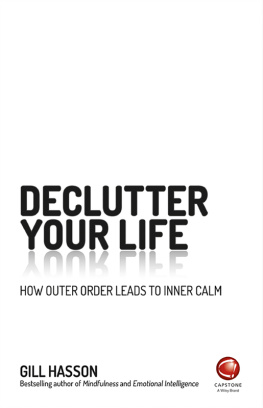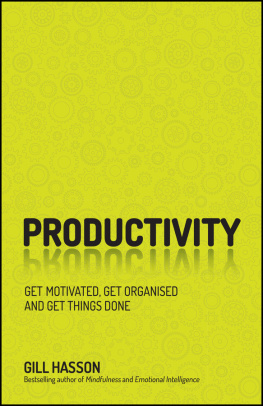
This edition first published 2017
2017 Gill Hasson
Registered office
John Wiley & Sons Ltd, The Atrium, Southern Gate, Chichester, West Sussex, PO19 8SQ, United Kingdom
For details of our global editorial offices, for customer services and for information about how to apply for permission to reuse the copyright material in this book please see our website at www.wiley.com.
The right of the author to be identified as the author of this work has been asserted in accordance with the Copyright, Designs and Patents Act 1988.
All rights reserved. No part of this publication may be reproduced, stored in a retrieval system, or transmitted, in any form or by any means, electronic, mechanical, photocopying, recording or otherwise, except as permitted by the UK Copyright, Designs and Patents Act 1988, without the prior permission of the publisher.
Wiley publishes in a variety of print and electronic formats and by print-on-demand. Some material included with standard print versions of this book may not be included in e-books or in print-on-demand. If this book refers to media such as a CD or DVD that is not included in the version you purchased, you may download this material at http://booksupport.wiley.com. For more information about Wiley products, visit www.wiley.com.
Designations used by companies to distinguish their products are often claimed as trademarks. All brand names and product names used in this book and on its cover are trade names, service marks, trademarks or registered trademarks of their respective owners. The publisher and the book are not associated with any product or vendor mentioned in this book. None of the companies referenced within the book have endorsed the book.
Limit of Liability/Disclaimer of Warranty: While the publisher and author have used their best efforts in preparing this book, they make no representations or warranties with respect to the accuracy or completeness of the contents of this book and specifically disclaim any implied warranties of merchantability or fitness for a particular purpose. It is sold on the understanding that the publisher is not engaged in rendering professional services and neither the publisher nor the author shall be liable for damages arising herefrom. If professional advice or other expert assistance is required, the services of a competent professional should be sought.
Library of Congress Cataloging-in-Publication Data
Names: Hasson, Gill, author.
Title: Positive thinking : find happiness and achieve your goals through the power of
positive thought / Gill Hasson.
Description: Chichester, West Sussex, UK : John Wiley & Sons, 2017. |
Includes index.
Identifiers: LCCN 2016029047| ISBN 9780857086839 (pbk.)
Subjects: LCSH: Attitude (Psychology) | Positive psychology. | Self-esteem.
Classification: LCC BF327 .H387 2017 | DDC 150.19/88--dc23 LC record available at
https://lccn.loc.gov/2016029047
A catalogue record for this book is available from the British Library.
ISBN 978-0-857-08683-9 (pbk)
ISBN 978-0-857-08692-1 (ebk) ISBN 978-0-857-08691-4 (ebk)
Cover design: Wiley
Introduction
What do you want? Why do you think positive thinking might help?
Perhaps you want to start your own business, change your job or career, start a relationship, improve a relationship, travel the world. Perhaps you simply want to feel happier and more positive each day.
Maybe you need some positivity to help you cope with a disappointment, setback or even a trauma or tragedy.
Whatever it is, you may have decided that things need to improve and that what could help would be a more positive perspective and approach. You're right; a positive perspective and approach can help.
But is there really power in positive thinking? Yes.
The fact is, if you're not a positive thinker if you don't have a positive attitude there's not much that can make up for it. Money, education, talent and opportunities are all well and good but without positive thinking you can't really make the most of them. Other people can't be positive for you. They can be supportive and encouraging but then it's over to you.
There simply is no substitute for having your own positive attitude. It gives you the motivation, energy and ability to succeed, it enables you to be happy and keeps you going through the toughest times.
A positive attitude is the difference maker. So how can you get this difference maker in your life? This book will explain how.
Part 1 introduces you to the concepts of positive and negative thinking. It explains that what you think and say to yourself can have quite an impact on what you can and can't do. Think positively and you'll feel able to manage and do well. Let negative thoughts take a hold, and you're likely to feel overwhelmed and powerless.
So why, if negative thinking is so unhelpful to us, do we think in negative ways? Chapter 1 explains why. And there's a questionnaire for you to complete, which will give you an idea of just how negative or positive you currently are.
If you are more inclined to think in negative ways, the good news is that once you're more aware of your negative thoughts, you're in a better position to disempower them. In Chapter 2 you'll learn how to challenge negative thoughts and choose more helpful, positive ways of thinking.
You'll also learn about a new approach a mindful approach which suggests that instead of challenging negative thoughts, you simply accept and let go of those thoughts and turn your attention, time and energy to the outcomes you would really prefer.
Some people claim that positive thinking is unrealistic; that you can't get what you want in life simply by being positive and optimistic and suppressing or ignoring the negative aspects of life. It's true; that is unrealistic.
It's unrealistic because positive thinking is more than a way to manage your thoughts positive thinking is about what you think and what you do. It involves being proactive. Positive thinking needs to be followed by positive action. Chapter 3 explains this. It explains what you can do to achieve your goals and get what you want and it explains how positive thinking can help support you in your efforts.
Whatever it is you want to do, though, whatever goals you're aiming to achieve, it's quite possible that despite your good intentions, you either can't get yourself started or you've got started but now you're flagging. Part 2 begins by explaining, in Chapter 4, a number of ways that you can develop your willpower and motivation and keep going.
With positive thinking, what you're aiming for is to make it a habit. A positive habit. Chapter 5 has a range of ideas, tips and techniques for establishing a positive mindset. You'll discover that the more you train your brain to think positively, the more likely you'll have helpful, positive thoughts and beliefs that will soon become your normal way of thinking.
Continuing with the theme of developing and maintaining positive thinking, Chapter 6 looks at the links between positive thinking, self-esteem and confidence. When your self-esteem is high, your thoughts and beliefs about yourself are positive; you feel good about yourself and you're more likely to believe that you can do things, things can turn out well and you can cope with setbacks. It's a helpful, positive dynamic where each aspect feeds into the other. Chapter 6 suggests a variety of ways that you can build your self-esteem and confidence and tap into that positive dynamic.
So far, then, so good. But what if you're currently facing challenges and setbacks? What if you've experienced trauma and even tragedy? How can positive thinking be of any real practical help?
Next page
















